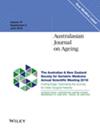Frailty in Older Patients With Atrial Fibrillation and Its Relationship With Anticoagulant Use: A Multi-Centred Observational Study in New South Wales
Abstract
Objectives
This study aimed to examine the prevalence of frailty in hospitalised older patients with atrial fibrillation (AF) and its relationship with oral anticoagulant (OAC) prescription during admission. The secondary aim was to examine the association between frailty and rate-/rhythm-control medication prescriptions.
Methods
This retrospective observational study included adults aged 65 years or older with AF admitted to six hospitals in Australia in 2022. Frailty was defined by a Frailty Index ≥ 0.25. Logistic regression models were applied to examine the association between frailty and the prescriptions of OAC, rate-control and rhythm-control drugs during hospitalisation. Results are presented as odds ratios (OR) and 95% confidence intervals (CI).
Results
There were 685 patients, with a mean age of 82.6 (SD 8.3), 50% female and 43% identified as frail. Overall, 76% were prescribed OAC (68% in the frail versus 81% in the non-frail, p < 0.001), 38% received rate-control drugs (42% in the frail vs. 34% in the non-frail, p = 0.04), 27% received rhythm-control drugs (23% in the frail vs. 31% in the non-frail, p = 0.02). The adjusted ORs of frailty on prescriptions were 0.58 (95% CI 0.39–0.86) for OAC, 1.75 (95% CI 1.22–2.52) for rate-control drugs and 0.83 (95% CI 0.55–1.24) for rhythm-control drugs.
Conclusions
The study revealed a high prevalence of frailty in older inpatients with AF. Frailty was associated with reduced likelihood of prescription of OAC and increased likelihood of prescribing rate-control medications, with no independent impact on rhythm-control therapy. Further studies are needed to understand these prescribing patterns.


 求助内容:
求助内容: 应助结果提醒方式:
应助结果提醒方式:


